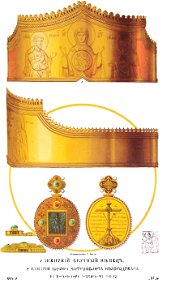— a woman's wedding crown. B — a panagia of joseph, metropolitan of vologda (kept in the assumption cathedral in moscow) in the sacristy of the assumption cathedral in moscow, ancient, silver and gilded wedding crowns, male and female, which were placed on tsars and tsarinas at weddings, have been preserved. They are designed in the form of a hoop, protruding on the forehead as a crown, with gorodki along the edges; on one of them the deesis is carved, and on the other — the sign of the mother of god, the ancestors of god joachim and anna. Judging by the style of work, these crowns belong to the 17th century; their shape is similar to the ancient ones made of silver, copper, iron and wood, which were used at weddings. The crown in general as a symbol of eternity, and especially the wedding crown as a sign of a mysterious union, a reward for chastity and heavenly blessings, was known to the jews, as is evident from the words of the prophet isaiah (lxi, 10): "as he placed a crown upon the bridegroom. " in the song of songs (iii, 11) the divine bridegroom is represented in a crown "with which his mother crowned him, and on the day of his betrothal, and on the day of the joy of his heart. " the eastern orthodox church introduced crowns into use at weddings, which, according to the interpretation of st. John chrysostom, signified "victory over temptations and the union of two into one flesh. " from them, the wedding itself is called a coronation, i. E. A church blessing, which is bestowed upon the newlyweds with the placing of crowns on their heads. The wedding was preceded by betrothal with rings, as a preparatory part of the marriage, as a sign of "betrothal to the lord god of the honorable church"; the husband's ring was gold, the wife's - iron or silver, as a sign of the superiority and dominion of one, the subordination and obedience of the other. In ancient prayer books there is also a rite of tonsure, performed in the form of a cross on the head of the married, before the laying of the crowns, which until then lay on the altar on the throne. After the wedding, in the litany, the newlyweds were called prince and princess. It may be that these names were given to them because in the first centuries of christianity in rus' only princes and boyars were married; for nestor's contemporary, jacob the black monk, represented to metropolitan john that "the blessing of a wedding does not happen to ordinary people, but only boyars and princes are married. " for seven days the crowns were not removed from the newlyweds; on the eighth day the crowns were released. This church rite was performed with the prayer set out in the "bible": thanksgiving to god for the newlyweds' observance of chastity. Subsequently, these rites were shortened and the wedding crowns were given the form of a crown. On print no. 36, together with the wedding crown, a golden saint's panagia is depicted; on its front side is inserted an ancient cameo representing the prophet daniel (рспцюфзт дбнйюл) with two lions at his foot; around the cameo are four precious stones in nests, placed crosswise. On the back side is carved a cross on golgotha with a crown between the crosses, with a spear and a cane; on the margins is the following inscription: “in this icon are the relics of the holy apostle andrew the first-called and the holy apostle barnabas, the holy great martyr george, the holy martyr anfenogen, and the relics of tsar constantine. ” although the inscription on the print indicates that this panagia belonged to “joseph, metropolitan of vologda,” there were no metropolitans among the hierarchs of the vologda diocese, but only bishops and archbishops, among whom are archbishop joseph i (consecrated in 1708) and joseph ii (consecrated in 1761). According to the cathedral inventory, this panagia is known by the name of iosifovskaya because it was taken from the iosifovsky volokolamsk monastery, where the all-russian metropolitan daniel, defrocked in 1539, ended his life. This panagia probably belonged to him; as evidenced by the image of the prophet daniel, who shares his name, on it. After the death of this saint, known in civil history for his quarrels with the boyars, and in church literature for his polemical writings, this sign of his episcopacy, probably according to his will, was sent to the dormition cathedral, where he was installed as all-russian metropolitan on february 27, 1522, from among the abbots of the iosifovsky volokolamsk monastery. Date: 1846—1853.
Loading...
